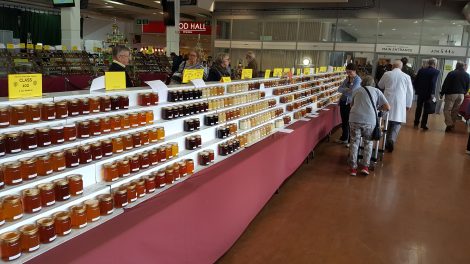 Abraham Lincoln
If given the truth, the people can be depended upon to meet any national crisis...
Abraham Lincoln
If given the truth, the people can be depended upon to meet any national crisis...
 Guildford news...
for Guildford people, brought to you by Guildford reporters - Guildford's own news service
Guildford news...
for Guildford people, brought to you by Guildford reporters - Guildford's own news service
Beekeeper’s Notes: Why Even Guildford Has Such A Variety Of Honeys
Published on: 1 Nov, 2018
Updated on: 3 Nov, 2018
By Hugh Coakley
Before I started keeping bees, I thought that honey was more or less the same wherever you got it. Oh foolish person!
Little did I know that there was a vast variety of honey available even in a small town like Guildford. It isn’t difficult to see why.

Honey displays at the National Honey Show in 2016 with a range of honeys from a delicate yellow to nearly treacle-coloured.
Our urban areas, with large and small gardens, building sites, river banks and parks, have a huge range and diversity of wild and cultivated flowers. Any bees foraging in these areas will get whatever is there at the time. But then they will make a lovely multi-floral honey.
Closer to the countryside, you have more of a chance – or a risk – of a single crop honey.
It can be oil-seed rape in the spring which goes solid if you don’t extract it quickly enough. Or even the prized heather honey for those living close to the heather on Whitmoor Common for instance or at Hindhead.
Because I keep my bees in the same locality, I tend to get a more or less predictable honey each year. My honey is generally light and floral in the spring and darker and more fruity in the autumn but even that varies from year to year.
Whatever it is, every local beekeeper’s honey will be unique and different. I think that I read that the UK beekeeper keeps on average only four hives, getting around 150 to 200 lbs of honey each year.
Shop around in butchers and farm shops and try the differences.
An article in this month’s beekeeper’s magazine reported the findings from Dublin City University and Trinity College Dublin that Irish heather honey has similar levels of powerful antioxidants as Manuka honey. Presumably, it would also apply to English or even the humble Guildford heather honey?
The same magazine reported on testing of supermarket honeys in Australia. Twelve of the 28 samples taken were found to be adulterated. EU testing in 2015 found 14% of honeys in the supply chain had added sugar.
The message is to buy local. You can get a surprising variety of pure, local honeys, and even the benefits of Manuka but without the air-miles.
Recent Articles
- Guildford Institute’s Crowdfunding Project for Accessible Toilet in its New Community and Wellbeing Centre
- Letter: Guildford – Another Opportunity Missed?
- Letter: GBC’s Corporate Strategy – Where Is the Ambition?
- My Memories of John Mayall at a Ground-breaking Gig in Guildford Nearly Six Decades Ago
- Westborough HMO Plans ‘Losing the Heart of the Street’ Says Resident
- College Invests to Boost Surrey’s Economy and Close Digital Skills Gap
- Community Lottery Brings Big Wins for Local Charities
- GBC Housing Plan Promises ‘A Vibrant Urban Neighbourhood’ Near Town Centre
- Hospital Pillows ‘Shortage’ at the Royal Surrey
- Updated: Caravans Set Up Camp at Ash Manor School


Search in Site
Media Gallery
Dragon Interview: Local Artist Leaves Her Mark At One of England’s Most Historic Buildings
January 21, 2023 / No Comment / Read MoreDragon Interview: Lib Dem Planning Chair: ‘Current Policy Doesn’t Work for Local People’
January 19, 2023 / No Comment / Read MoreA3 Tunnel in Guildford ‘Necessary’ for New Homes, Says Guildford’s MP
January 10, 2023 / No Comment / Read More‘Madness’ for London Road Scheme to Go Ahead Against ‘Huge Opposition’, Says SCC Leader
January 6, 2023 / No Comment / Read MoreCouncillor’s Son Starts Campaign for More Consultation on North Street Plan
December 30, 2022 / No Comment / Read MoreCounty Council Climbs Down Over London Road Works – Further ‘Engagement’ Period Announced
December 14, 2022 / No Comment / Read MoreDragon Interview: GBC Reaction to the Government’s Expected Decision to Relax Housing Targets
December 7, 2022 / No Comment / Read MoreHow Can Our Town Centre Businesses Recover? Watch the Shop Front Debate
May 18, 2020 / No Comment / Read More









Recent Comments